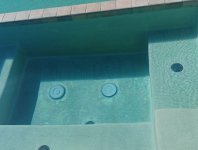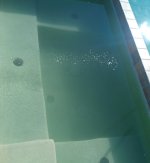I've been in the hospital for a while so I came back to what seemed to be a green-bottomed pool.

But the water itself was actually crystal clear, as shown by looking at the unused hot tub floor.

So I hooked the 90 feet of 1-1/2 inch vacuum hose to the main pump debris canister vacuum.

And I hooked the other end of the vacuum hose to a manual floor vacuum on a 20-foot pole.

And I was pleasantly surprised all of the settled green dust vacuumed up easily with that setup.

But then I noticed the return water (in the hot tub) was kind of abnormally muddy green looking.

Which indicates, to me, the filter isn't catching everything as it's letting some green mud through.
So I emptied the hot tub to take a look at what exactly this fine green mud feels to the hand.

It's kind of pasty. Like super fine clay. Not gritty at all. Kind of like flour between my fingers.
My questions?
Just an explanation from people who have far more experience with green mud than I do.
My first and main question is whether or not it's normal for a perfectly good filter (only a year old!) to allow "some" of the green mud back into the pool?
My second question is what is this stuff that doesn't grow in the water but just uniformly settles down to the walls and bottom.
Is it green algae?
It does NOT grow in colonies if it is algae.
It does not color the water (unless I stir it up).
It simply is a extremely fine dust that settled only in the pool (not in the hot tub).
Any idea what it is and why "some" of it (not much, but some) got through the filter?
Is that normal?

But the water itself was actually crystal clear, as shown by looking at the unused hot tub floor.

So I hooked the 90 feet of 1-1/2 inch vacuum hose to the main pump debris canister vacuum.

And I hooked the other end of the vacuum hose to a manual floor vacuum on a 20-foot pole.

And I was pleasantly surprised all of the settled green dust vacuumed up easily with that setup.

But then I noticed the return water (in the hot tub) was kind of abnormally muddy green looking.

Which indicates, to me, the filter isn't catching everything as it's letting some green mud through.
So I emptied the hot tub to take a look at what exactly this fine green mud feels to the hand.

It's kind of pasty. Like super fine clay. Not gritty at all. Kind of like flour between my fingers.
My questions?
Just an explanation from people who have far more experience with green mud than I do.
My first and main question is whether or not it's normal for a perfectly good filter (only a year old!) to allow "some" of the green mud back into the pool?
My second question is what is this stuff that doesn't grow in the water but just uniformly settles down to the walls and bottom.
Is it green algae?
It does NOT grow in colonies if it is algae.
It does not color the water (unless I stir it up).
It simply is a extremely fine dust that settled only in the pool (not in the hot tub).
Any idea what it is and why "some" of it (not much, but some) got through the filter?
Is that normal?
Last edited:





